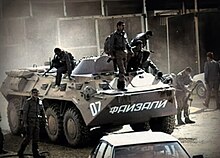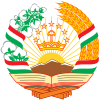Portal:Tajikistan: Difference between revisions
updating recognized content |
|||
| Line 71: | Line 71: | ||
}} |
}} |
||
<!-- Start of content generated by JL-Bot --> |
<!-- Start of content generated by JL-Bot --> |
||
===Good articles=== |
|||
{{columns-list|colwidth=30em| |
|||
*[[:Tajik alphabet]] |
|||
*[[:Tajikistan at the 2002 Winter Olympics]] |
|||
*[[:Tajikistan at the 2006 Winter Olympics]] |
|||
*[[:Tajikistan at the 2010 Winter Olympics]] |
|||
*[[:Tajikistan at the 2016 Summer Paralympics]] |
|||
}} |
|||
<!-- End of content generated by JL-Bot --> |
<!-- End of content generated by JL-Bot --> |
||
{{Box-footer}} |
{{Box-footer}} |
||
Revision as of 20:55, 26 January 2019
Introduction

Tajikistan, officially the Republic of Tajikistan, is a landlocked country in Central Asia. Dushanbe is the capital and most populous city. Tajikistan is bordered by Afghanistan to the south, Uzbekistan to the west, Kyrgyzstan to the north, and China to the east. It is separated from Pakistan by Afghanistan's Wakhan Corridor.
The territory was previously home to cultures of the Neolithic and the Bronze Age, including the city of Sarazm, and was later home to kingdoms ruled by people of faiths and cultures, including the Oxus civilization, Andronovo culture, Buddhism, Nestorian Christianity, Hinduism, Zoroastrianism, Manichaeism, and Islam. The area has been ruled by empires and dynasties, including the Achaemenid Empire, Sasanian Empire, Hephthalite Empire, Samanid Empire, and Mongol Empire. After being ruled by the Timurid Empire and Khanate of Bukhara, the Timurid Renaissance flourished. The region was later conquered by the Russian Empire and subsequently by the Soviet Union. Within the Soviet Union, the country's borders were drawn when it was part of Uzbekistan as an autonomous republic before becoming a full-fledged Soviet republic in 1929. (Full article...)
Selected general articles
The president, who is directly elected, is both the head of state and the head of government. The president appoints the prime minister and all the members of the government, without the need of parliamentary approval. Tajikistan is thus a presidential republic. Tajikistan held a constitutional referendum on 22 June 2003 and the 2003 Constitution, among other amendments, set a limit of two seven-year terms for the president. Emomali Rahmon's election to the office of the president in 2006 counts as his first 7-year term under the 2003 Constitution, and was re-elected for a second term in 2013, remaining in office until 2020. Rahmon holds the title of 'Leader of the Nation' and is therefore exempt from presidential term limits. This title also grants him and his family legal immunity.
In this geographically divided country, the ceremonial position of prime minister traditionally is held by a person from the north to nominally balance President Emomali Rahmon’s southern origin. In 2004 the executive branch fell further under the control of the governing party as appointments by Rahmon left the opposition with only 5 percent of major government positions. This event followed the expiration of the 1997 peace guarantee that the United Tajik Opposition (UTO) would occupy at least 30 percent of top government positions. Prior to the 2006 election, the Council of Ministers, which executes the decisions of the president, included two deputy prime ministers, 19 ministers, nine committee heads, and several ex officio members. After the election, Rahmon abolished 10 ministries and five state committees and reappointed Oqil Oqilov as prime minister. Rahmon is said to have accumulated substantial informal power through patronage. (Full article...)

Tajik cuisine is a traditional cuisine of Tajikistan, and has much in common with Russian, Afghan, Iranian and Uzbek cuisines. Plov (pilaf) (Tajik: палав, Uzbek: palov), also called osh (Tajik: ош), is the national dish in Tajikistan, as in other countries in the region. Green tea is the national drink. (Full article...)

"Surudi Milli" is the national anthem of Tajikistan, officially adopted on 7 September 1994. (Full article...)
Tajikistan is a partner country of the EU INOGATE energy programme, which has four key topics: enhancing energy security, convergence of member state energy markets on the basis of EU internal energy market principles, supporting sustainable energy development, and attracting investment for energy projects of common and regional interest. (Full article...)

Tajik, also called Tajiki Persian or Tajiki, is the variety of Persian spoken in Tajikistan and Uzbekistan by Tajiks. It is closely related to neighbouring Dari of Afghanistan with which it forms a continuum of mutually intelligible varieties of the Persian language. Several scholars consider Tajik as a dialectal variety of Persian rather than a language on its own. The popularity of this conception of Tajik as a variety of Persian was such that, during the period in which Tajik intellectuals were trying to establish Tajik as a language separate from Persian, prominent intellectual Sadriddin Ayni counterargued that Tajik was not a "bastardised dialect" of Persian. The issue of whether Tajik and Persian are to be considered two dialects of a single language or two discrete languages has political sides to it.
By way of Early New Persian, Tajik, like Iranian Persian and Dari Persian, is a continuation of Middle Persian, the official religious and literary language of the Sasanian Empire (224–651 CE), itself a continuation of Old Persian, the language of the Achaemenids (550–330 BC). (Full article...)
The prime minister of Tajikistan (Сарвазири Ҷумҳурии Тоҷикистон) is the title held by the head of government of Tajikistan. After the president, the prime minister is second most powerful person of the country. The prime minister coordinates the work of the Cabinet and advises and assists the president in the execution of the functions of government. (Full article...)

Tajik literature and its history is bound up with the standardisation of the Tajik language. Tajik literary centres include the cities of Bukhara and Samarkand, currently in present-day Uzbekistan but with a majority Tajik population and Balkh and Herat in Afghanistan.
During the Soviet era, the principal literary output was socialist realism in nature. (Full article...)

Most of rugged Tajikistan's transportation system was built during the Soviet era, and since that time the system has deteriorated badly because of insufficient investment and maintenance. In 2013, Tajikistan, like many of the other Central Asian countries, was experiencing major development in its transportation sector. Beginning in 2005, a series of major transportation projects begun. The first such project, the Anzob Tunnel, was inaugurated in 2006, providing a year-round road link from Dushanbe to northern Tajikistan. (Full article...)

The State Emblem of Tajikistan is a modified version of the original emblem of the Tajik Soviet Socialist Republic that was in use until the dissolution of the Soviet Union in 1991. (Full article...)
- one autonomous region (Russian: автономная область; Tajik: вилояти мухтор, romanized: viloyati mukhtor)
- two regions (Tajik: вилоятҳо, romanized: viloyatho, Persian: ولایتها), sing. viloyat, Persian: ولایت, Russian: область/вилоят)
- the districts under republic subordination
- the capital city, Dushanbe.
Before the Soviet era, which began in Central Asia in the early 1920s, the area designated today as the Republic of Tajikistan underwent a series of population changes that brought with them political and cultural influences from the Turkic and Mongol peoples of the Eurasian steppe, China, Iran, Russia, and other contiguous regions. The Tajik people came fully under Russian rule after a series of military campaigns that began in the 1860s, at the end of the nineteenth century. (Full article...)
For most of the population, radio and television are the most important sources of information. During the civil war (1992–97), the Emomali Rahmon government severely repressed both broadcast and print media; since that time, neither has recovered independent operations. In 2006 six government television stations and 18 private stations were in operation, but most of the latter depended on government transmission equipment. Although the law requires registration of independent broadcast outlets, some unlicensed stations have operated. Russian channels are received by satellite, and most regions receive one of the two national television channels. Radio stations broadcast in Persian, Russian, Tajik, and Uzbek. In 2000 there were 141 radios and 326 television sets per 1,000 population. Televizioni Tojikiston is the state-run public broadcaster. (Full article...)

Islam is the predominant religion in Tajikistan.
Islam was brought to the region by the Arabs in the 7th century. Since that time, it has become an integral part of Tajik culture. Tajikistan is a secular country, but the post-Soviet era has seen a marked increase in religious practice in the country. The majority of Tajikistan's Muslims adhere to the Sunni branch of Islam, and a smaller group (mostly in Gorno-Badakhshan in the east) belong to the Shia branch of Islam. The Russian Orthodox faith is the most widely practiced of other religions, although the Russian community shrank significantly in the early 1990s. Some other small Christian groups now enjoy relative freedom of worship. Tajikistan also has a small Jewish community. (Full article...)
Did you know...
- ... that Rudaki is acknowledged as the founder of New Persian poetry in Iran and the father of Tajik literature in Tajikistan?
Need help?
Do you have a question about Tajikistan that you can't find the answer to?
Consider asking it at the Wikipedia reference desk.
Get involved
For editor resources and to collaborate with other editors on improving Wikipedia's Tajikistan-related articles, see WikiProject Tajikistan.
Selected images
In the news
- 27 April 2024 – Crocus City Hall attack
- Authorities in Russia arrest a fifth suspect in last month's attack on a music venue in Krasnogorsk, Moscow Oblast, Russia, a Tajik man accused of providing the attackers with financing and communication. (AP)
Subcategories
Subtopics
Recognized content
| This is a list of recognized content, updated weekly by JL-Bot (talk · contribs) (typically on Saturdays). There is no need to edit the list yourself. If an article is missing from the list, make sure it is tagged (e.g. {{WikiProject Tajikistan}}) or categorized correctly and wait for the next update. See WP:RECOG for configuration options. |
Good articles
Associated Wikimedia
The following Wikimedia Foundation sister projects provide more on this subject:
-
Commons
Free media repository -
Wikibooks
Free textbooks and manuals -
Wikidata
Free knowledge base -
Wikinews
Free-content news -
Wikiquote
Collection of quotations -
Wikisource
Free-content library -
Wikiversity
Free learning tools -
Wiktionary
Dictionary and thesaurus






































